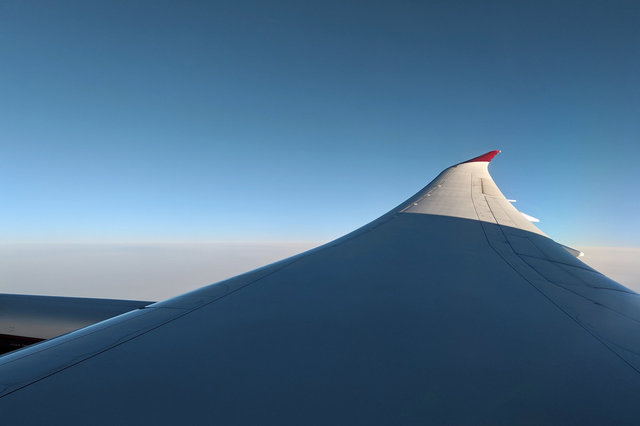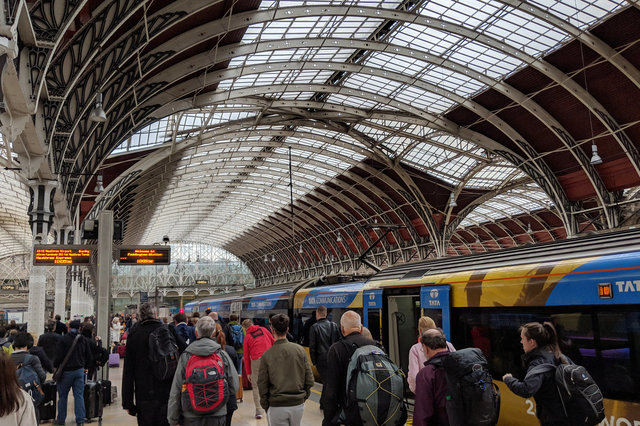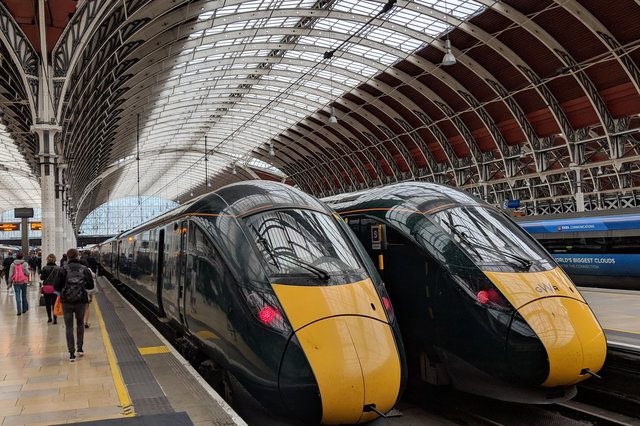SS Great Britain
Started: 2019-05-13 21:24:28
Submitted: 2019-05-14 00:20:57
Visibility: World-readable
26th April 2019: In which the intrepid narrator flies to London, takes the train to Bristol, and sees the handiwork of the Greatest Engineer of the World
Despite moving to Seattle last summer, I still work on an SRE team with its counterpart in London (covering the other twelve hours of the clock, providing twenty-four hours of coverage without anyone having to get up in the middle of the night). This means that I have the opportunity to visit them every once and a while (as I did, with my prior team, on two previous occasions, in 2016 and again in 2018).
By the time I ramped up on my new team, and settled (more or less) into Seattle, it was the middle of winter, and I wasn't especially enthusiastic about visiting stereotypically-wet-and-gray London in the middle of winter (though Seattle gets more rain overall and has more rainy days than London, so it might have been an improvement). As the northern hemisphere started to tilt back towards the sun I began to worry about the looming cliff of Brexit at the end of March; then the UK and EU kicked that can down the road long enough for me to be confident that there was going to be a UK for me to go visit, so when I found an open week on my calendar at the end of April I jumped on the opportunity and scheduled a visit to London.
I left North America on the afternoon of Friday, 26th April on a Virgin Atlantic 787-9 named "Birthday Girl", on a direct flight from Seattle to London-Heathrow. (Seattle has three daily flights to Heathrow, two operated by British Airways and one operated by Virgin Atlantic. I picked Virgin Atlantic mostly because they partner with Delta and I'm trying to standardize my airline miles on Delta now that I live in a Delta hub city.) This was my first time flying Virgin Atlantic; I was bemused that the ground operation was entirely staffed by ground crew in Delta uniforms, and I was pleased that the TSA finally got around to letting foreign-flagged carriers send me through PreCheck so I could breeze through security in relative luxury.
Virgin Atlantic let me buy a "Premium" seat for less than my employer's flight cap, which put me in the middle class of accommodation, in a 2-3-2 seat configuration in a cozy cabin right above the main wing (which probably would have been "Business" class fifteen years ago). The seat was bigger than economy class, but the space under the seat to store my bag was smaller than I expected; I had trouble fitting my over-the-shoulder laptop bag and ended up stowing it in the over-head compartment for the flight. (I also ended up in an aisle seat instead of my preference of a window seat, so I could only sporadically watch the real scenery outside the window.)
After the in-flight dinner service, I watched half of Mission: Impossible 6, then tried to sleep. This proved easier said than done, due at least in part to the fussy baby in the economy bulkhead row immediately behind me, on the other side of a permeable curtain. (It also didn't help that my flight left at 15:00 PDT so by the time I tried to sleep it was barely early evening back in my home time zone.) I eventually gave up trying to sleep, watched the rest of the movie, and rested fitfully until the cabin crew emerged to serve breakfast prior to landing. I don't think I actually ended up with any real sleep on the plane, which didn't bode well for my attempts to meet jet lag head-on with a good night's sleep.
We landed under overcast skies, taxied past and between jumbo jets from dozens of countries ("the golden age of aviation", I noted when I posted the picture above on Twitter, because I can climb into a plastic bottle and emerge nine hours later on another continent), and disembarked at Heathrow's terminal 3. Once I cleared immigration and customs I bought a local SIM card for my mobile phone (from the vending machine conveniently located right outside international arrivals) and got breakfast at the nearest crowded coffee shop.
Properly fortified, I set out to find the Heathrow Express train to Paddington (confused only somewhat by the fact that I emerged at a part of Terminal 3 that I wasn't familiar with from my last two visits to London). I rode the express train fifteen minutes to Paddington Station, emerging under the graceful open iron arches of Isambard Kingdom Brunel's great terminal station, still serving as the Great Western Mainline's terminus in London.
In Paddington Station I bought a return ticket to Bristol, and went through a different set of fare gates, past a pair of brand-new Class 800 dual-power diesel-electric and electric locomotives painted a splendid dark green with yellow trim in the colors of the Great Western Railway. My train had its pantograph retracted; most of the Great Western Mainline isn't yet electrified, so my train would be powered by diesel for its journey to Bristol. (The locomotives are ready for the future with pantographs waiting for the completion of the electrification project.)
I found a window seat in one of the carriages half-way down the platform and waited for the train to depart. It was mid-morning in London, and I tried to avoid doing the time zone conversion that would tell me that it was the middle of the night back in my home time zone, which explained why I was tired. I rested on the train, as we glided out of Paddington Station with the gentle purr of the diesel engine soothing me to sleep, but the other passengers were boisterous enjoying their weekend trip to Bristol, keeping me awake even as I wanted to sleep.
My train took 1 hour, 45 minutes to reach its terminus at Bristol-Temple Meads, another Brunel-designed station with a soaring iron roof arching gracefully over the tracks. I bought a savory stuffed pastry for lunch, then ate it in front of the train station, watching the mid-day traffic go by.
I got turned around trying to find my hotel, which was supposed to be a short walk from the train station, but there was construction on the roundabouts in front of the station that routed pedestrian traffic in a circuitous route three times longer than it was pre-diversion. I checked into my hotel and felt much better after taking a shower. It was early afternoon and I was ready to play tourist in Bristol.
The first thing I saw, immediately behind my hotel, was the bombed-out Temple Church, a twelfth-century church that had fallen victim to bombing in World War II when Bristol's industry and shipping were under attack. The wooden roof had burned, but the masonry survived, albeit fenced off with signs warning of unstable walls.
The main tower survived, but with a noticeable tilt outwards, and I couldn't help but think of Notre Dame, recently in the news for its catastrophic fire; and of the bombed-out churches I saw in Berlin.
I followed the map on my phone across the Floating Harbour (formerly the tidal River Avon, now dammed to provide a consistent water level), down narrow side streets like any European city (also substantially rebuilt after World War II). I walked along the harbor until I reached my destination, the reason I'd come all the way to Bristol: SS Great Britain, the world's first iron-hulled screw-powered steam ship, designed and launched by the one and only Isambard Kingdom Brunel, the greatest engineer in the world.
The historic ship now rests in the very drydock she was built in, now carefully humidity controlled to prevent her iron hull from rusting any further. To give the illusion that she's still sea-worthy and floating (and to make it obvious where the water line would be), the museum built a pond with a few inches of water on top of sheets of glass at the water line. From below, the light shining through the water cast rippled shadows on the ground, giving the illusion of being under water.
I walked around the bottom of the drydock, circumnavigating the hull of the historic ship, studying how the plate iron was decaying and peeling away in places, revealing the structure of the rivets that kept the hull together. I didn't touch the ship, but I paraphrased Data's line in Star Trek: First Contact:
I am detecting imperfections in the iron hull, temperature variations in the coal manifolds. Somehow the experience is much more real for me than it was before.
At the stern of the ship the museum had installed a replica of the original screw and rudder, trying to illustrate what the ship had looked like when it was built -- including the first-ever screw in an ocean liner, providing superior power and maneuverability than the then-standard side-wheel paddle-wheel ships.
Every corner of the hull was amazing, showing the work done to build and maintain the hull, and the evolution of the ship through its useful life.
I climbed out of the dry dock and entered the nearby gallery showing the history of the ship, working backwards from when the ship was rescued off a reef in the 1970s and carried on a barge across the ocean to Bristol, through its earlier lives: as a coal barge, as a discount ocean liner carrying immigrants to Australia (53 days, one-way, taking advantage of the winds when it could to save coal), and as a luxury ocean liner extending the reach of the Great Western Railway from Bristol across the ocean to New York.
I crossed the boarding bridge onto the weather deck of the ship. From its position in a cramped drydock on the edge of a narrow harbor it was difficult to imagine what it would have been like to be on the ship at sea. I climbed down the stairs onto the inner decks, segregated by class with the first-class passengers towards the stern, with ample space to socialize (but with tiny cabins to live in); and the second-class passengers towards the bow, with tiny bunks in shared dorms that did not seem remotely livable. I couldn't imagine staying in the ship for more than a couple of hours, let alone a 53-day voyage to Australia.
I disembarked and visited the gallery on the other side of the ship, indulging in the photo opportunity to get a selfie of myself in a top hat in front of the launching chains for the SS Great Eastern, a poor replica of the famous image of Brunel himself.
This gallery showed more artifacts from the museum's collection of Brunel's papers, including original drawings for various projects. The museum leaned into the Brunel hagiography but I was more than willing to indulge them every step of the way.
I emerged through the gift shop, selling a wide variety of Brunel merchandise, including a top-hat-wearing cigar-chomping rubber ducky and teddy bear. I escaped with only a magnet and only one book.
When I emerged it was raining heavily. I dashed through the rain to the museum's cafe, where I ate a scone with clotted cream with coffee. By the time I had finished the rain had cleared and the sun was out again, as if to ask whether I had really seen the rain or just imagined it.
I walked along the floating harbour towards my hotel, braving several more bouts of rain followed by sun, and ate supper at an Asian restaurant serving vegetarian pho. I returned to my hotel to retire early, exhausted from jet-lag but pleased to have visited a new place and seen the handiwork of the greatest engineer in the world.
For more photos of SS Great Britain and Bristol, see Photos on 2019-04-27.




















